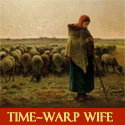
Manners & Etiquette Wednesday
 Have you ever had that awkward moment when you are at someones home and they ask you to "please set the dinner table"??? You're brain freezes and you PANIC, because YOU can't remember which side of the plate the fork goes on and where the water glass belongs!!!! Well you are not alone. Quite often I have gone to set my dinner table and had to run to my Emily Post guide to remember which forks go where!
Have you ever had that awkward moment when you are at someones home and they ask you to "please set the dinner table"??? You're brain freezes and you PANIC, because YOU can't remember which side of the plate the fork goes on and where the water glass belongs!!!! Well you are not alone. Quite often I have gone to set my dinner table and had to run to my Emily Post guide to remember which forks go where!


Our first table setting is known as the Basic Table Setting. The basic Table setting can be used in just about any everyday dining occasion at your home. It is a nice option to have when planning your table scape for company.
For a basic table setting, here are two great tips to help you and your family remember the order of plates and utensils:
1.Picture the word "FORKS." The order, left to right, is:
F for Fork,
O for the Plate (the shape!),
K for Knives and
(Okay -- you have to forget the R because it really doesn't have a place, but you get the idea!)
2. Holding your hands in front of you, touch the tips of your thumbs to the tips of your forefingers to make a lowercase 'b' with your left hand and a lowercase 'd' with your right hand. This reminds you that "bread and butter" go to the left of the place setting and "drinks" go on the right. Emily Post could have used that trick -- she was often confused about which bread and butter belonged to her -- and sometimes she used her neighbor's! In which case, when it was called to her attention, she would say to the dismayed lady or gentleman, "Oh, I am always mixing them up. Here, please take mine!"
Other Fabulous Facts:
•Knife blades always face the plate
•The napkin goes to the left of the fork, or on the plate
•The bread and butter knife are optional
Informal Place Setting
You would most likely use an Inofrmal Place Setting during a holiday dinner, when hubby's boss comes to dinner or a special occasion inside of the home. When an informal three-course dinner is served, the typical place setting includes these utensils and dishes:

The illustration above shows how a table would be set for the following menu:
•Soup course
•Salad or first course
•Entree
•Dessert
(a) Dinner plate: This is the "hub of the wheel" and is usually the first thing to be set on the table. In our illustration, the dinner plate would be placed where the napkin is, with the napkin on top of the plate.
(b) Two Forks: The forks are placed to the left of the plate. The dinner fork, the larger of the two forks, is used for the main course; the smaller fork is used for a salad or an appetizer. The forks are arranged according to when you need to use them, following an "outside-in" order. If the small fork is needed for an appetizer or a salad served before the main course, then it is placed on the left (outside) of the dinner fork; if the salad is served after the main course, then the small fork is placed to the right (inside) of the dinner fork, next to the plate.
(c) Napkin: The napkin is folded or put in a napkin ring and placed either to the left of the forks or on the center of the dinner plate. Sometimes, a folded napkin is placed under the forks.
(d) Dinner Knife: The dinner knife is set immediately to the right of the plate, cutting edge facing inward. (If the main course is meat, a steak knife can take the place of the dinner knife.) At an informal meal, the dinner knife may be used for all courses, but a dirty knife should never be placed on the table, place mat or tablecloth.
(e) Spoons: Spoons go to the right of the knife. In our illustration, soup is being served first, so the soup spoon goes to the far (outside) right of the dinner knife; the teaspoon or dessert spoon, which will be used last, goes to the left (inside) of the soup spoon, next to the dinner knife.
(f) Glasses: Drinking glasses of any kind -- water, wine, juice, iced tea -- are placed at the top right of the dinner plate, above the knives and spoons.
Other dishes and utensils are optional, depending on what is being served, but may include:
(g) Salad Plate: This is placed to the left of the forks. If salad is to be eaten with the meal, you can forgo the salad plate and serve it directly on the dinner plate. However, if the entree contains gravy or anything runny, it is better to serve the salad on a separate plate to keep things neater.
(h) Bread Plate with Butter Knife: If used, the bread plate goes above the forks, with the butter knife placed diagonally across the edge of the plate, handle on the right side and blade facing down.
(i) Dessert Spoon and Fork: These can be placed either horizontally above the dinner plate (the spoon on top with its handle facing to the right; the fork below with its handle facing left); or beside the plate. If placed beside the plate, the fork goes on the left side, closest to the plate (because it will be the last fork used) and the spoon goes on the right side of the plate, to the right of the dinner knife and to the left of the soup spoon.
(j) Coffee Cup and Saucer: Our illustration shows a table setting that would be common in a restaurant serving a large number of people at once, with coffee being served during the meal. The coffee cup and saucer are placed above and to the right of the knife and spoons. At home, most people serve coffee after the meal. In that case the cups and saucers are brought tot he table and placed above and to the right of the knives and spoons.
Finally, we have our last place setting , The Formal Table Setting. This is by far the more fancy of the three place settings and by far the most elegant. You would use this type of place setting in formal occasions and events such a as; weddings, anniversary parties, special occasion birthday parties, as a ball or formal charitable event.
The Formal Place Setting

The one rule for a formal table is for everything to be geometrically spaced: the centerpiece at the exact center; the place settings at equal distances; and the utensils balanced. Beyond these placemats, you can vary flower arrangements and decorations as you like.
The placement of utensils is guided by the menu, the idea being that you use utensils in an "outside in" order. For the illustrated place setting here, the order of the menu is:
•Appetizer: Shellfish
•First Course: Soup or fruit
•Fish Course
•Entree
•Salad
(a) Service Plate: This large plate, also called a charger, serves as an under plate for the plate holding the first course, which will be brought to the table. When the first course is cleared, the service plate remains until the plate holding the entree is served, at which point the two plates are exchanged. The charger may serve as the under plate for several courses which precede the entree.
(b) Butter Plate: The small butter plate is placed above the forks at the left of the place setting.
(c) Dinner Fork: The largest of the forks, also called the place fork, is placed on the left of the plate. Other smaller forks for other courses are arranged to the left or right of the dinner fork, according to when they will be used.
(d) Fish Fork: If there is a fish course, this small fork is placed farthest to the left of the dinner fork because it is the first fork used.
(e) Salad Fork: If the salad is served after the entree, the small salad fork is placed to the right of the dinner fork, next to the plate. If the salad is to be served first, and fish second, then the forks would be arranged (left to right): salad fork, fish fork, dinner fork.
(f) Dinner Knife: The large dinner knife is placed to the right of the dinner plate.
(g) Fish Knife: The specially shaped fish knife goes to the right of the dinner knife.
(h) Salad Knife (Note: there is no salad knife in the illustration): If used, according to the above menu, it would be placed to the left of the dinner knife, next to the dinner plate. If the salad is to be served first, and fish second, then the knives would be arranged (left to right): dinner knife, fish knife, salad knife.
(i) Soup Spoon or Fruit Spoon: If soup or fruit is served as a first course, then the accompanying spoon goes to the right of the knives.
(j) Oyster Fork: If shellfish are to be served, the oyster fork goes to the right of the spoons. Note: it is the only fork ever placed on the right of the plate.
(k) Butter Knife: The small spreader is paced diagonally on top of the butter plate, handle on the right and blade down.
(l) Glasses: These can number up to five and are placed so that the smaller ones are up front. The water goblet (la) is placed directly above the knives. Just to the right goes a champagne flute (lb); in front of these are placed a red (lc) or white (ld) wine glass and a sherry glass (le).
(m) Napkin: The napkin is placed on top of the charger (if one is used) or in the space for the plate.
In General:
•Knife blades are always placed with the cutting edge toward the plate.
•No more than three of any implement is ever placed on the table, except when an oyster fork is used in addition to three other forks. If more than three courses are served before dessert, then the utensil for the fourth course is brought in with the food; likewise the salad fork and knife may be brought in when the salad course is served.
•Dessert spoons and forks are brought in on the dessert plate just before dessert is served.
Well I hope this has been a fun little refresher for all of you lovely ladies who love to play hostess! :)
Blessings,
Sarah























2 comments:
Thank you so much for this refresher..this is so important to know and I too have been in a panic while trying to set the table at someone's house! I am printing this out for my two girls, ages 10 and 4! Thank you Thank you! Jaime
Thanks for posting this wonderful information! You are truly brilliant for having this clearly stated instructions.
Anyway, just to share one of the budget friendly e-shopping store on the net that I encountered is the yourchaircovers.com. I also bookmarked this site co'z I think this would help me if I will be holding any special occasions.I found this site to offers fabulous and amazing chair covers, tablecloths and other luxurious items you might need on a party. It's a great discounted store with lots of amazing items!
Post a Comment